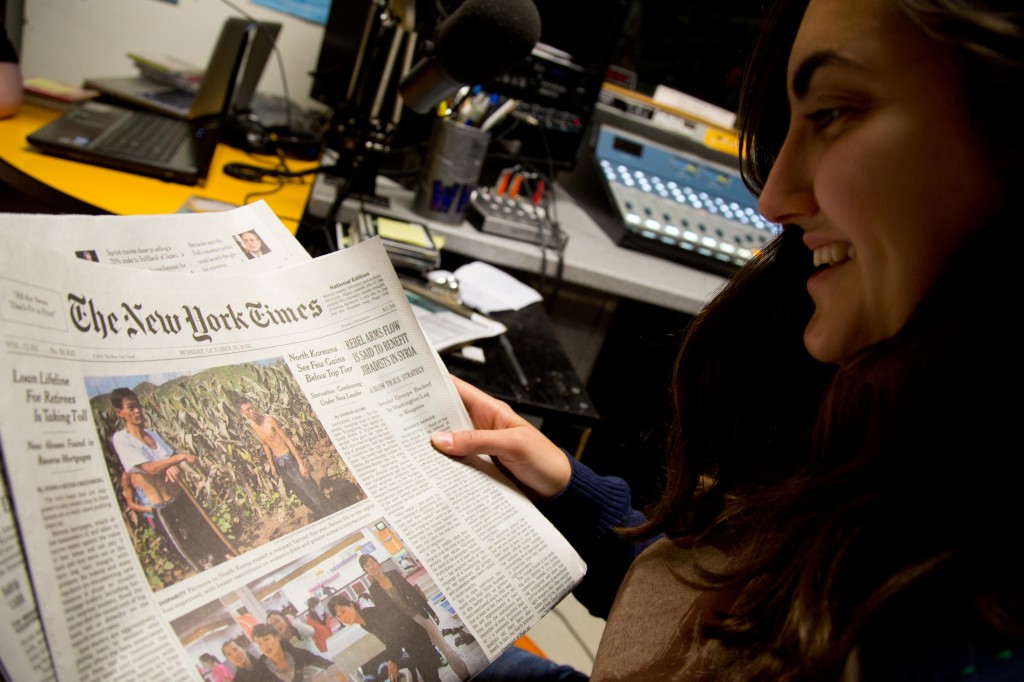
After the Student Association Vice President for Academic Affairs (VPAA) secured funding for the New York Times Readership Program on campus in October, Aaron Ricks can now guarantee 300 copies of the paper will be available through most of next semester.
VPAA Aaron Ricks obtained enough funding — $14,505, roughly $2,000 short for next semester — from the Off-Campus Community Council, the Dean of Students Office, Sodexo and some of the on-campus communities, to be able to distribute 300 copies of The New York Times each day.
“It’s looking like we’ll sustain 300 for the rest of the semester,” Ricks said. “Honestly, I’m falling short of my goal of 400. It’s just a matter of fundraising at this point.”
Ricks said he is confident the program will continue through the next school year. He said because of the nature of this year’s funding, with Ricks going to several different student services offices to petition for funds, neither he nor the University administration want to continue in that manner.
“One, [the program] is a service people are coming to expect at this point on campus and secondly, the administration doesn’t want me knocking on their door every year or my successors knocking on their door every year for money,” Ricks said. “I think everyone on this campus realizes that. It’s just a matter of funding, it’s no one’s fault. That’s just how it was. No one I know has $25,000 laying around.”
He was disappointed by how much time he spent trying to secure funding for the program rather than managing the program and trying to figure out how to improve the program and track its progress.
According to Ricks, the SA has tossed around the idea of tying the New York Times Program to a campus fee to create sustainable funding to keep the program going year after year instead of panhandling for funds.
“There’s plenty of [fees] on campus, there’s plenty of them in this University,” Ricks said. “It would be a nominal fee increase or attached. A dollar per student per semester would probably cover most if not all of the program.”
Ricks said some people in the University get jumpy when they hear the price of the program, but he insists there are less reputable ventures on which more money is spent.
“One of the things people don’t know about the program, we don’t pay for the ones we don’t use,” Ricks said. “We’re still sending those reports, we’re still getting reimbursed back for those.”
Ricks said that the $25,000 price tag for the New York Times Program includes a limited number of online subscriptions and that they are an additional benefit that he has not yet implemented.
“In the beginning, the [subscription] funding was a priority,” Ricks said. “I promised the campus I was going to get that, so I’m going to do whatever I can to get that next semester.”
However, funding for online subscriptions to the New York Times may not be necessary. Students can gain unlimited access to New York Times articles by deleting the cookies from their Internet browsers or deleting anything that appears after the .html in the location bar.
“I read the news on my computer everyday,” Ricks said. “But then you take away the Times program and you see the type of uproar that happened in my office in the beginning of the semester. Students liked it. And if that were true, then why are 90 percent, 95 percent of our papers being taken everyday? If people don’t like it, then stop picking them up. If people are so opposed to it. That’s why I’m not advocating for one paper per student.”
Ricks said that even though there are other ways students can get the news, The New York Times is a staple for many students at Binghamton.
“This is The New York Times, it’s the hometown newspaper for most of these people,” Ricks said. “Honestly, I’m not from New York City, I never read The New York Times growing up, but I read it now.”


